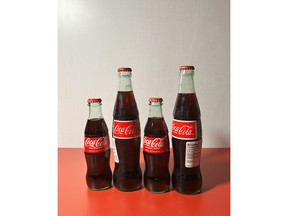Is Mexican Coke really better than the U.S. version? We put it to the test

Article content
Reviews and recommendations are unbiased and products are independently selected. Postmedia may earn an affiliate commission from purchases made through links on this page.
This week, President Donald Trump delivered an out-of-the-blue announcement: He had spoken with Coca-Cola executives, he said, and they had agreed to start making Coke in the United States with cane sugar, instead of with high-fructose corn syrup.
There was much to unpack in this declaration – for starters, whether Coca-Cola was actually on board with the move. (The company released a statement thanking the president for his “enthusiasm” and promised unspecified “new innovative offerings” in the future.) And, some skeptics wondered, was Trump just attempting to score a win on a popular matter to distract from a particularly tumultuous week, in which even his die-hard supporters are agitated over his handling of the case of deceased sex offender Jeffrey Epstein?
The proposed change also seemed to echo Health and Human Services Secretary Robert F. Kennedy Jr., whose campaign to “Make America Healthy Again” includes weeding out high-fructose corn syrup, along with artificial dyes and other additives, from U.S. food products. Kennedy has blamed corn syrup for diseases including obesity and diabetes.
Whatever Trump’s motivations and however real the prospect, many cola quaffers were delighted by the idea. Coke made in Mexico, where it is still produced with cane sugar, has a devoted following stateside. People have long raved about its more natural, authentic taste, compared with the formula used in the United States since the mid-1980s that has relied on high-fructose corn syrup for sweetness. Coca-Cola makes its products with sugar, not corn syrup, in other countries, including Britain and other parts of Europe. U.S. customers are probably more familiar with the Mexican version because it is widely imported.
But wait a second, we thought. Was it possible that we were collectively deluding ourselves, perhaps persuaded by our bias toward a more natural, less processed product? Scientists have said that there is minimal nutritional difference between sugar and high-fructose corn syrup. Were we seduced by the nostalgia factor that Mexican Coke’s glass bottles evoke? Maybe we were victims of the all-too-human inclination to feel just a tiny bit superior by declaring the status quo to be inferior.
We decided to test the premise widely held by some food-loving folks: that Mexican Coke is far better than the domestic stuff.

The differences
Coke made in Mexico lists the following ingredients: carbonated water, cane sugar, caramel color, phosphoric acid, natural flavours and caffeine. U.S. Coke lists the same ingredients, except for the sweetener: carbonated water, high-fructose corn syrup, caramel color, phosphoric acid, natural flavours and caffeine.
Mexican Coke typically comes in glass bottles, whereas the U.S. variety is often found in plastic bottles or cans – although it is available in eight-ounce glass bottles, too. Some fans claim that glass is a superior vessel that does not impart any off flavours, unlike plastic or aluminum, although Coca-Cola insists that the cola is exactly the same regardless of the container and suggests that our “perception of taste” can be influenced.
The methodology
We purchased imported Mexican Coke (which is widely available; ours came from a local Giant), as well as U.S.-made Coca-Cola, opting for the glass-bottled version to make the taste test as apples-to-apples as possible.
We invited six colleagues – including a couple of sworn aficionados of Mexican Coke – to a blind taste test in which we served two samples, labeled only as “A” and “B.” Each was served, freshly opened and poured, in a plain drinking glass, to remove any visual cues that might affect drinkers’ perceptions. We asked which one they thought was which – and which one they preferred.
The verdict
Five out of six correctly identified the Mexican Coke, and all five judged it to be their favourite. The lone outlying taster, a self-declared Mexican Coke superfan, unwittingly picked the U.S. version as his favourite.
The quality of the sweetness was the determining factor, according to our tasters. Mexican Coke had “more of a natural sugar taste,” said one, while another found it showed off “a more pleasant sweetness – almost like a deeper, more dimensional sweetness.”
Tasters thought the U.S. version, by contrast, had a “flat” sugary character and gave off “a syrupy smell.” Another clocked a “lingering aftertaste” in the domestic drink.
A couple of tasters thought the Mexican version was pleasantly fizzier and lighter-bodied than the U.S. version. “Slightly more carbonated,” as one put it. The extra bubbles elevated it, they found: “It tastes crisper.”











Postmedia is committed to maintaining a lively but civil forum for discussion. Please keep comments relevant and respectful. Comments may take up to an hour to appear on the site. You will receive an email if there is a reply to your comment, an update to a thread you follow or if a user you follow comments. Visit our Community Guidelines for more information.